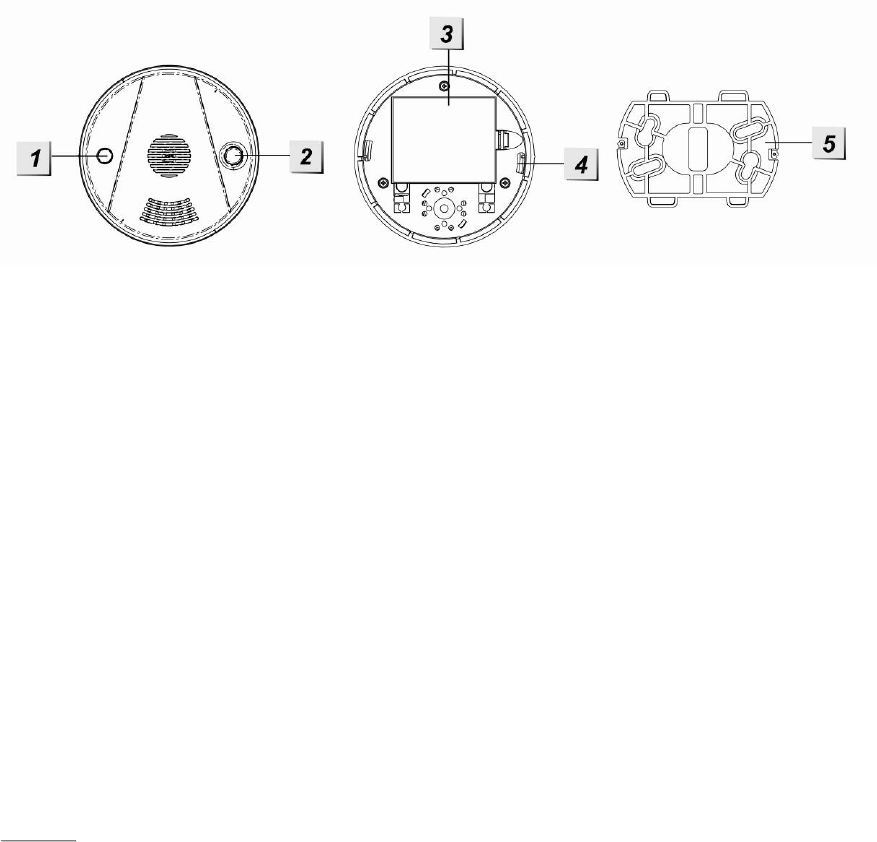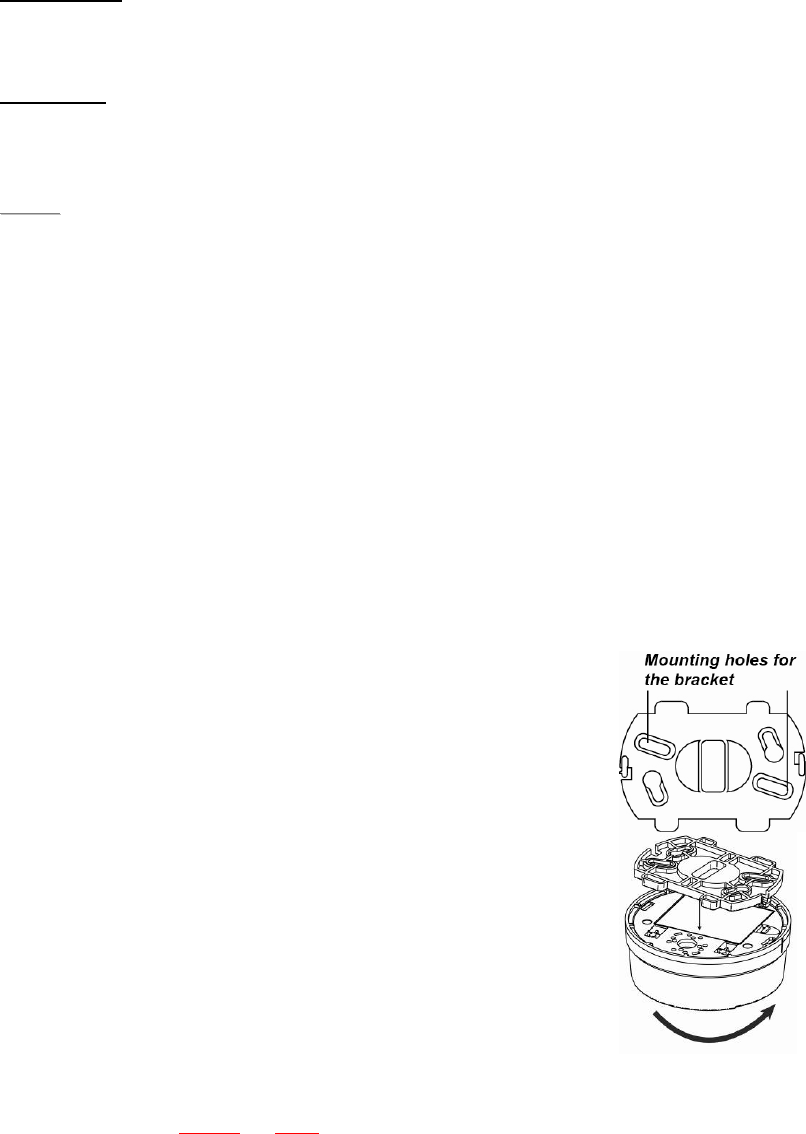Climax Technology Co HDZW Heat Detector User Manual HD 9ZW 20151113 FCC
Climax Technology Co Ltd Heat Detector HD 9ZW 20151113 FCC
Users Manual

1
H
He
ea
at
t
D
De
et
te
ec
ct
to
or
r
(
(H
HD
D-
-9
9Z
ZW
W)
)
HD-9 is a heat detector with both rate-of-rise and fixed temperature sensors insides. It provides capacities of monitoring the
rate of any rise in temperature and detecting a household temperature that may lead to a fire disaster. It is ideal for
applications for the environment affected by heat, such as kitchen.
The Heat Detector is a Z-Wave enabled device and is fully compatible with any Z-Wave enabled network.
Z-Wave is a wireless communication protocol that uses a low-power RF radio. By taking advantage of the Z-Wave mesh
network, commands can be transmitted to their destination via intermediary “listening” Z-Wave products.
HD-9 is designed to detect two temperature conditions. It signals an alarm if temperature increases by 8.3 °C per minute.
The alarm is also activated if the temperature exceeds the threshold temperature of 57.3°C. The intelligent design allows
appropriate action to be taken and eliminates fire hazards.
1. Red LED
z When HD-9 is reporting an alarm, the LED will turn on for 1.5 seconds, and afterwards, the LED will flash until
the temperature is restored.
z When the Heat Detector has low battery, the LED will flash once every 30 seconds (HD-9 will also emit a beep)
z When the temperature sensor of HD-9 is out-of-order, the LED will flash once every 60 seconds (HD-9 will also
emit a beep)
z During Alarm Silence period, the LED will flash once per second.
2.Test Button
z Press 3 times within 1.5 seconds to transmit a learn code and HD-9 will emit a 2-tone beep
z Press once to test if the Heat Detector is functioning normally
z Press once to silence the alarm
3. Battery compartment
4. Mounting Hole
5. Mounting Bracket
z
z
B
Ba
at
tt
te
er
ry
y
z 3 “AA” Alkaline batteries are used to supply power.
z The Heat Detector will report its battery percentage to the Control Panel respectively at 100%, 75%, 50% and
25%. If the battery voltage is low (25%), a Low Battery signal will be sent to the Control Panel to notify the user.
z When the Heat Detector is under low battery condition, a low battery signal will be transmitted along with
regular signal transmissions. If the battery voltage is low, HD-9 will emit one beep and the LED will flash
once every 30 seconds and inform the Control Panel regularly.
<
<N
NO
OT
TE
E>
>
) When changing batteries, after removing the old batteries, press the Test button twice to fully discharge
before inserting new batteries.
z
z
A
Ad
dd
di
in
ng
g
D
De
ev
vi
ic
ce
e
(
(I
In
nc
cl
lu
us
si
io
on
n)
)
This product can be included and operated in any Z-Wave network with other Z-Wave certified devices from other
manufactures and/or other applications. All non-battery operated nodes within the network will act as repeaters
regardless of vendor to increase reliability of the network.
z Insert the 3 “AA” batteries into the battery compartment connecting the correct polarity as shown on the
battery compartment lid.
z HD-9 will emit a 2-tone beep.
z Put the Z-Wave gateway or control panel into Inclusion or Learning mode (please refer to the Z-Wave
gateway or control panel manual).

2
z Within 1.5 seconds, press the Test Button 3 times. HD-9 will emit a 2-tone beep.
z Refer to the operation manual of the Z-Wave gateway or control panel to complete the learn-in process.
z If the sensor has already been included (learnt) into another Z-Wave Gateway/Control Panel, or if the
sensor is unable to be learnt into the current Z-Wave Gateway/Control Panel, please exclude it first (see
Exclusion) before attempting to include it into the current Z-Wave Gateway/Control Panel.
z
z
R
Re
em
mo
ov
vi
in
ng
g
D
De
ev
vi
ic
ce
e
(
(E
Ex
xc
cl
lu
us
si
io
on
n)
)
The Heat Detector must be removed from existing Z-Wave network before being included into another. There are two
methods available to exclude a device.
Exclusion Mode
z Put the Z-Wave gateway or control panel into Exclusion mode (please refer to the Z-Wave gateway or
control panel manual).
z Within 1.5 seconds, press the Test Button 3 times and the Heat Detector will be removed from the Z-Wave
network.
Factory Reset
(Only use factory reset when network Control Panel/Gateway is missing or inoperable).
z Remove the batteries of the Heat Detector first.
z Press and hold the Test Button. While holding the Test Button, power on the Heat Detector by re-inserting
the batteries, wait for 10 seconds to factory reset.
<
<N
NO
OT
TE
E>
>
) Factory resetting the Heat Detector will restore it to factory default settings (excluded from the Z-Wave
network). The Z-Wave gateway or control panel will still keep its Z-Wave settings. Please refer to the
gateway or control panel manual on how to remove the Heat Detector’s Z-Wave settings.
z
z
R
Ra
an
ng
ge
e
T
Te
es
st
t
To test whether the device is able to communicate with the Z-Wave gateway or control panel:
z Put the gateway / panel into range test mode (Walk Test).
z Press the Test Button on the device
z The gateway / panel should display if the device is within the operation range (please refer to the operation
manual of the gateway / panel).
z
z
Z
Z-
-W
Wa
av
ve
e
S
Sl
le
ee
ep
p
M
Mo
od
de
e
z The Heat Detector will enter Z-Wave Sleep mode (to conserve power) after waking up for a short period of
time (~10 seconds). While in Z-Wave sleep mode, Z-Wave gateways or control panels are unable to send
commands to the Heat Detector.
z To program the Heat Detector, please send command(s) to the Heat Detector within the wake-up period.
z
z
M
Mo
ou
un
nt
ti
in
ng
g
z Using the bracket as a template, mark the two holes according to the picture on
the right to stabilize the bracket onto the surface.
z Insert the dowels.
z Screw the screws into the dowels to stabilize the bracket. The two hooks should
be facing you.
z Locate the single line mark on the detector and line it up with one of the hooks
of the bracket. After both hooks fits in the two mounting holes on the detector,
rotate the detector clockwise to lock onto the bracket.
z
z
T
Te
es
st
ti
in
ng
g
t
th
he
e
H
He
ea
at
t
D
De
et
te
ec
ct
to
or
r
By pressing the Test button on the Heat Detector, you can test if the Heat Detector is
functioning normally.
z If the Heat Detector functions normally, the LED will turn on for 1 second
followed by emitting a 2-tone beep.
z If the “Temperature Sensor” of the Heat Detector is out-of-order, the buzzer
will emit the 2-tone beep for 3 times.
z The Heat Detector is out-of-order if nothing happens (buzzer or LED).
z
z
S
Su
up
pe
er
rv
vi
is
so
or
ry
y
S
Si
ig
gn
na
al
l
This function uses the Z-Wave Wake Up Command Class. The Wake Up Command Class allows the
battery-powered Heat Detector to notify the Control Panel/Gateway that it is awake and ready to receive any queued
commands. The wake up interval time period is programmed automatically according to Control Panel’s setting when

3
The Heat Detector is included. The recommended setting of the wake up time is 60 minutes above.
z
z
T
Te
em
mp
pe
er
ra
at
tu
ur
re
e
D
De
et
te
ec
ct
ti
io
on
n
z Once the temperature rises by 8.3 °C per minute (rise rate) or exceeds the threshold temperature of 57.3 °C,
the Heat Detector lights up its LED to indicate it is sending an alarm report. HD-9 then activates its buzzer
with LED flashing rapidly for 10 seconds for local warning.
z After this 10-second local warning period, HD-9 performs a follow-up temperature check. If the temperature
is found to be alarming still, HD-9 will repeat another 10 seconds of local warning with buzzer and rapid
flashing LED.
z HD-9 will repeatedly perform follow-up checks until the temperature is lower than the set value of 49°C or the
temperature falls by 4°C. The alarm will stop automatically if the temperature drops below 49°C or falls by
4°C (for alarms triggered by temperature rise rate, the alarm will only stop if the temperature also drops
lower than 49°C). The alarm can also be stopped manually by using the “Alarm Silence” function.
z
z
A
Al
la
ar
rm
m
S
Si
il
le
en
nc
ce
e
z Once the alarm is started, pressing the Test button will put the Heat Detector into Alarm Silence mode for 10
minutes and the alarm will be stopped.
z During this 10-minute Alarm Silence period, the LED will flash once per second.
z After this 10-minute period is over, the Heat Detector will emit 2 beeps and then returns to normal operation
mode. If the temperature is still over the set threshold value, the Heat Detector will start alarming again.
z
z
I
In
ns
st
ta
al
ll
la
at
ti
io
on
n
N
No
ot
te
e
z It is recommended to install HD-9 at the center area of the ceiling.
z Do not locate the detector in the following locations:
¾ Close to a cooker, stove or oven
¾ High humidity area, such as location near dishwasher or washing machine.
¾ In front of air supply pile used for heating and air conditioning.
¾ Near ceiling fan or other high air flow area
z
z
Z
Z-
-W
Wa
av
ve
e
I
In
nf
fo
or
rm
ma
at
ti
io
on
n
Device Type: Sensor - Notification
Role Type: Reporting Sleeping Slave (RSS)
Command Class Support/Control
Mandatory CC Support: Association CC, v2 or newer
Association Group Information CC
Battery CC
Device Reset Locally CC
Manufacturer Specific CC
Notification CC
Powerlevel CC
Version CC, v2 or newer
Wake UP CC
Z-Wave Plus Info CC
z
z
Z
Z-
-W
Wa
av
ve
e’
’s
s
G
Gr
ro
ou
up
ps
s
(
(A
As
ss
so
oc
ci
ia
at
ti
io
on
n
C
Co
om
mm
ma
an
nd
d
C
Cl
la
as
ss
s
V
Ve
er
rs
si
io
on
n
2
2)
)
The Heat Detector can be set to send reports to associated Z-Wave devices. It supports 3 association groups with five
nodes each.
Group 1 for “LifeLine”:
Notification CC,V4 (COMMAND_CLASS_NOTIFICATION)
Battery CC (COMMAND_CLASS_BASIC)
Device Reset Locally CC
Group 2 for “Basic Set”:
Basic CC, v2 (COMMAND_CLASS_BASIC)
Group 3 for “Notification Report”:
Notification CC,V4 (COMMAND_CLASS_NOTIFICATION)
4
z Trigger Report (high temperature detected)
When the Heat Detector is triggered, it will transmit Notification command (Notification Type:0x04, Event:0x02)
to all nodes in Group1 and 3, and Basic set (0xFF) commands to the nodes in Group 2.
z Restore Report (High temperature calmed)
When high temperature cool down, it will transmit Notification command (Notification Type:0x04, Event:0x06)
to all nodes in Group 1 and 3, and Basic set (0x00) commands to the nodes in Group 2.
z Low Battery Report
1. When low battery voltage is detected, the Smoke Detector will transmit Battery command to all nodes in
Group 1.
2. When the Smoke Detector on low battery has its battery replaced, it will transmit Battery restore command
to all nodes in Group 1.
z Factory Reset
When the Smoke Detector is reset to factory default, it will send Device Reset Locally to all nodes in Group 1.
Federal Communication Commission Interference Statement
This equipment has been tested and found to comply with the limits for a Class B digital
device, pursuant to Part 15 of the FCC Rules. These limits are designed to provide
reasonable protection against harmful interference in a residential installation.
This equipment generates, uses and can radiate radio frequency energy and, if not installed
and used in accordance with the instructions, may cause harmful interference to radio
communications. However, there is no guarantee that interference will not occur in a
particular installation. If this equipment does cause harmful interference to radio or
television reception, which can be determined by turning the equipment off and on, the
user is encouraged to try to correct the interference by one of the following measures:
. Reorient or relocate the receiving antenna.
. Increase the separation between the equipment and receiver.
. Connect the equipment into an outlet on a circuit different from that to which the receiver
is connected.
. Consult the dealer or an experienced radio/TV technician for help.
FCC Caution:
To assure continued compliance, any changes or modifications not expressly approved by
the party responsible for compliance could void the user's authority to operate this
equipment. (Example - use only shielded interface cables when connecting to computer or
peripheral devices).
This device complies with Part 15 of the FCC Rules. Operation is subject to the following
two conditions:
(1) This device may not cause harmful interference, and
(2) This device must accept any interference received, including interference that may
cause undesired operation.